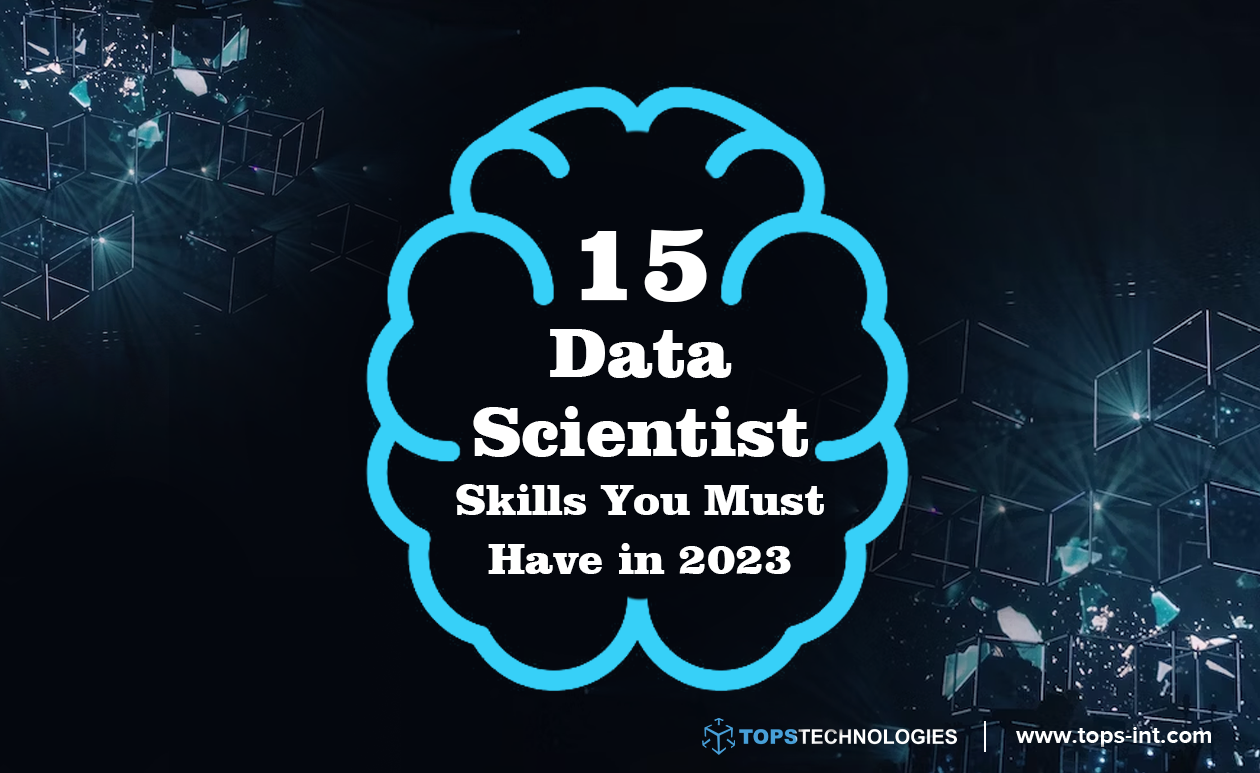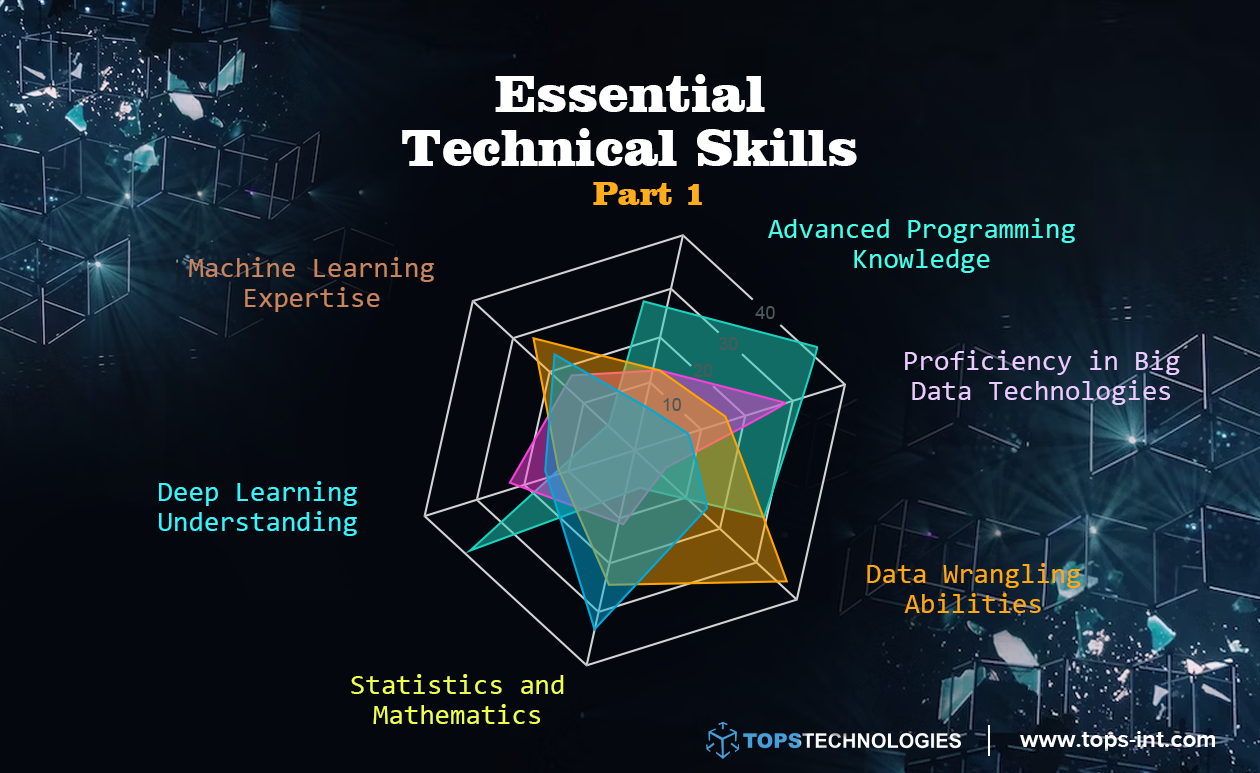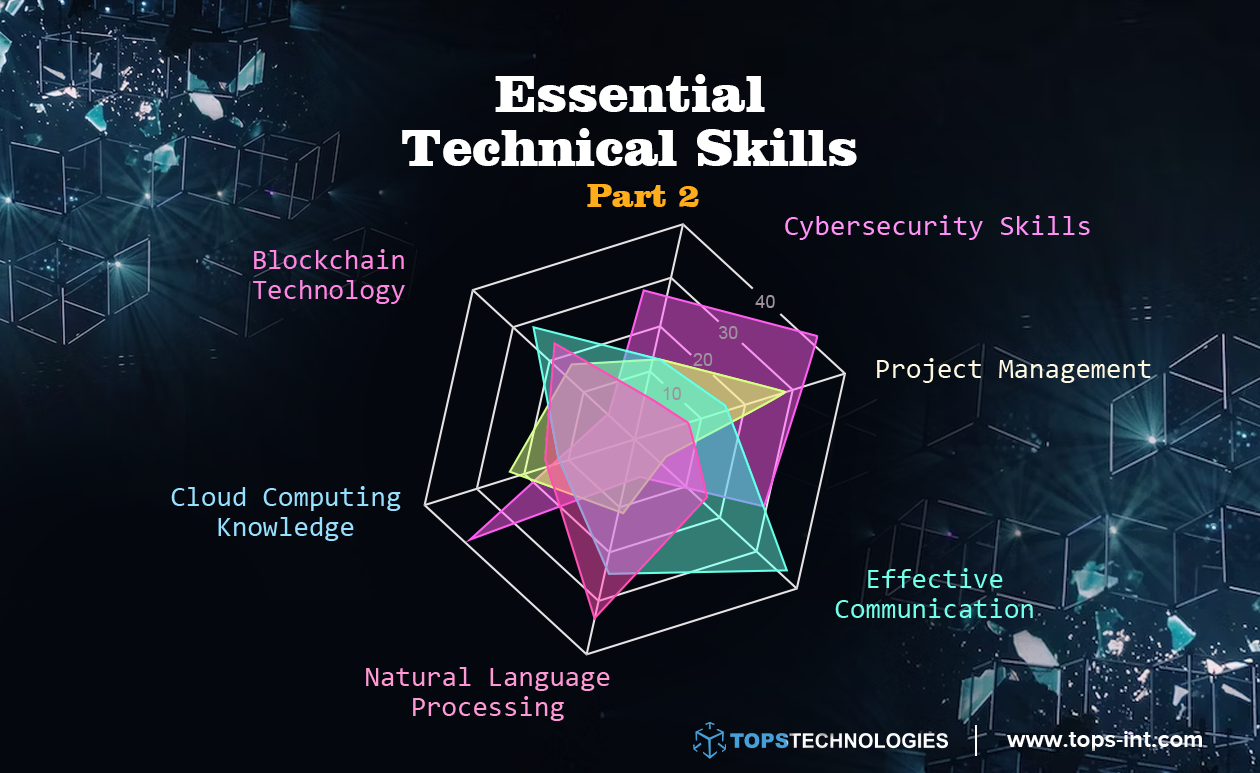
In the transformative world of data science, the landscape is continuously evolving.
The global big data market is expected to reach a staggering $103 billion. Amidst this growth, the role of data scientists is becoming more diversified and demanding.
There are different skills needed for data science. You can easily acquire these skills by taking a
Data Science Course in Ahmedabad! Let's look at the various skills needed in different job roles and the salaries you can get for those skills!
Data Analyst
- Skills Needed: Data Cleaning, Exploratory Data Analysis, Statistical Analysis
- Average Salary in India: ₹4,00,000 to ₹6,00,000 annually
Machine Learning Engineer
- Skills Needed: Machine Learning Algorithms, Python, Data Modeling
- Average Salary in India: ₹8,00,000 to ₹15,00,000 annually
Data Engineer
- Skills Needed: Big Data Technologies, ETL Processes, Database Management
- Average Salary in India: ₹8,00,000 to ₹12,00,000 annually
Business Intelligence Analyst
- Skills Needed: Data Warehousing, Data Visualization, Business Acumen
- Average Salary in India: ₹5,00,000 to ₹8,00,000 annually
The delineation of roles within data science highlights the breadth and depth of the field. As the industry continues to expand, the emphasis on specialized skills will further intensify.
The Role of a Data Scientist
In the burgeoning field of data science, the role of a Data Scientist is pivotal in harnessing data to drive organizational success.
- Data Analysis: Employing statistical tools to interpret complex datasets, providing actionable insights for informed decision-making.
- Machine Learning: Designing and implementing algorithms that allow machines to solve specific problems without explicit programming.
- Data Engineering: Ensuring the availability and consistency of data by creating robust data pipelines and infrastructure.
- Predictive Modelling: Utilising data and algorithms to forecast future events, aiding organizations in proactive decision-making.
- Data Visualization: Creating intuitive and interactive visual representations of data, facilitating easier comprehension and analysis.
In the context of enhancing skills and staying abreast with industry trends, pursuing a data science certification course in Ahmedabad or other regions is a prudent step.
Essential Technical Skills

Here are the most essential technical skills needed!
1. Advanced Programming Knowledge
In the realm of data science, advanced programming knowledge stands as the bedrock for navigating complex data challenges. The ability to write, understand, and debug code is fundamental to executing data science projects effectively.
Core Programming Languages
Python
R
SQL
Additional Technical Skills
- Algorithm Development: Crafting efficient algorithms for data processing and machine learning.
- Data Structures: Proficient understanding of various data structures for optimal data manipulation.
- Version Control Systems: Mastery in tools like Git for streamlined project management.
Over 60% of data scientists use Python, underscoring its significance in the field.
For individuals aspiring to excel in this domain, enrolling in a Data Science course with placement is a strategic move to solidify programming skills and gain comprehensive industry insights.
2 Machine Learning Expertise
In the sphere of data science, Machine Learning Expertise is a critical competency that propels innovative solutions and insights.
The ability to design and implement effective machine learning models is central to unlocking the potential of data for predictive analysis and decision-making.
Supervised Learning
- Building models that learn from labeled data.
- Scikit-Learn Documentation
Unsupervised Learning
- Uncovering patterns from unlabeled data.
- Unsupervised Learning Resources
Deep Learning
- Utilizing neural networks for complex problem-solving.
- TensorFlow Documentation
Essential Machine Learning Tools
- Scikit-Learn: For general-purpose machine learning.
- TensorFlow: Ideal for working with large datasets and neural networks.
- Keras: High-level neural networks API.
Around 89% of data science tasks will involve machine learning by 2023, emphasizing the importance of this skill.
For those in Surat seeking structured learning and comprehensive insights, opting for a Data Science Course in Surat can provide a robust foundation and a pathway to becoming adept in machine learning.
Read More: The Benefits of a Data Science Internship | How It Can Boost Your Career
3 Deep Learning Understanding
Deep learning, a subset of machine learning, employs neural networks to analyse various forms of data, offering enhanced accuracy in tasks like image and speech recognition.
Core Concepts
Here are the core concepts:
Neural Networks
- Foundational to deep learning, enabling complex data processing.
- Neural Networks Documentation
Convolutional Neural Networks (CNNs)
Recurrent Neural Networks (RNNs):
Popular Deep Learning Frameworks
- TensorFlow: Open-source software library for dataflow and differentiable programming.
- PyTorch: For computer vision and natural language processing tasks.
The deep learning market is expected to reach $18.16 billion, showcasing its growing relevance.
4 Proficiency in Big Data Technologies
Big Data Technologies facilitate the handling, analysis, and processing of large datasets that are beyond the capacity of traditional databases.
Essential Big Data Technologies
Here are the best technologies:
Hadoop
Spark
Kafka
Key Big Data Concepts
- Distributed Computing: Efficiently processing large datasets across multiple computers.
- Data Mining: Extracting useful information from large datasets.
- Data Storage: Managing and storing large volumes of data securely.
Within the next few years the world will create 163 zettabytes of data annually, highlighting the significance of big data technologies.
In the era of data, proficiency in big data technologies is indispensable.
5 Statistics and Mathematics
In the realm of data science, a solid foundation in Statistics and Mathematics is indispensable. It forms the backbone for data analysis, hypothesis testing, and predictive modeling, ensuring the derivation of accurate and reliable insights from data.
Core Statistical Concepts
Probability
Descriptive and Inferential Statistics
Regression Analysis
Essential Mathematical Knowledge
- Calculus and Linear Algebra: For understanding and solving complex problems.
- Discrete Mathematics: Essential for computer science and data algorithms.
The role of statistics and mathematics in data science is profound, offering the tools and frameworks necessary for comprehensive data analysis and problem-solving.
Read More: A Beginner’s Guide To Starting A Career In Data Science
6 Data Wrangling Abilities
Data wrangling, or data munging, involves cleaning, structuring, and enriching raw data into a desired format for better decision-making within an organization.
Data Cleaning
- Eliminating inconsistencies and errors for accurate analysis.
Remove Duplicates
Normalise Data
Outlier Detection
Feature Engineering
Validate Accuracy
Utilise Tools
Data Transformation
- Converting data from one format or structure into another.
Data Enrichment
- Enhancing data quality and value for improved insights.
- Collect Data: Gather data from various sources.
- Clean Data: Remove any errors, inconsistencies, or duplicates from the data.
- Transform Data: Convert the data into a suitable format for analysis.
- Enrich Data: Add additional information or insights to the data.
- Analyze Data: Analyse the enriched data to make informed decisions.
Essential Data Wrangling Tools
- Pandas: Python library for data manipulation and analysis.
- Trifacta: Modern platform for data preparation.
Data scientists spend approximately 60% of their time on data-wrangling tasks.
Mastering data wrangling abilities is crucial for overcoming data challenges and ensuring the reliability and usability of data for analytics and insights.
Emerging Skills in Data Science
7 Natural Language Processing
In the multifaceted domain of data science, Natural Language Processing (NLP) emerges as a critical subfield, bridging the gap between human communication and computer understanding.
It's the technology behind the scenes that enables machines to understand, interpret, generate, and respond to human language, facilitating seamless and intuitive human-machine interactions.
Core Components of NLP
Text Analytics
Involves extracting and assessing information from text data.

Speech Recognition
Translates spoken language into written text.

Language Generation
Enables machines to create human-like text based on input data.
NLP in Real-World Applications
- Chatbots: Enhancing customer service by providing instant, automated responses.
- Sentiment Analysis: Analysing social media and reviewing data to gauge public opinion and insights.
- Machine Translation: Automatically translating text from one language to another.
The global NLP market size is expected to reach USD 42.04 billion by 2026, reflecting its pervasive impact and utility.
The mastery of NLP concepts and techniques is essential for data scientists aiming to make a significant impact in this burgeoning field.
8 Cloud Computing Knowledge

In the contemporary data landscape, Cloud Computing Knowledge is a quintessential asset for data scientists.
It represents a shift from traditional computing, allowing access to computing resources (like servers, storage, databases, networking, software) over the internet (the cloud) to offer faster innovation, flexible resources, and economies of scale.
Key Aspects of Cloud Computing
Infrastructure as a Service (IaaS)
Provides virtualized computing resources over the internet.
IaaS Overview
- Infrastructure on Demand: Provides virtualized computing resources over the internet.
- Cost-Efficient: Eliminates the capital expense of hardware and physical infrastructure.
- Scalability: Easily scale resources up or down based on demand.
- Management: Users responsible for managing applications, data, runtime, and middleware.
Platform as a Service (PaaS)
Offers a platform allowing customers to develop, run, and manage applications.
PaaS Overview
- Platform for Developers: Provides a platform allowing customers to develop, run, and manage applications.
- Integrated Development Environment: Offers development tools, database management, and business analytics.
- Automatic Updates: Handles software updates, patching, and maintenance.
- Focus on Coding: This allows developers to focus on writing code without worrying about the underlying infrastructure.
Software as a Service (SaaS)
Delivers software applications over the Internet.
SaaS Overview
- Software over the Internet: Delivers software applications over the Internet on a subscription basis.
- Accessibility: Accessible from any device with an internet connection.
- Automatic Updates: Ensures users always have access to the latest features and security updates.
- Managed Security and Compliance: Providers handle security, compliance, and maintenance tasks.
Cloud Computing in Data Science
- Big Data Analytics: Cloud platforms offer tools for processing and analyzing big data.
- Machine Learning Platforms: Provides tools for building and deploying machine learning models.
- Data Storage and Backup: Ensures secure and scalable data storage solutions.
The global cloud computing market size is expected to grow to USD 832.1 billion by 2025, emphasizing its critical role in modern computing.
9 Blockchain Technology
Blockchain is a decentralized and distributed digital ledger used to record transactions across multiple computers, ensuring data security, transparency, and integrity.
Core Components of Blockchain
Decentralisation
Eliminates the need for a central authority, enhancing security.
Decentralisation Explained
- Distributed Control: Eliminates the need for a central authority or intermediary in a network.
- Enhanced Security: Provides increased security and privacy compared to centralized systems.
- Fault Tolerance: Offers better fault tolerance and resistance to attacks.
- Transparency and Immutability: Ensures transparent and unchangeable transaction records.
Smart Contracts
Self-executing contracts with the terms directly written into code.
Smart Contracts Guide
- Self-Executing Contracts: Automatically executes, controls, or documents legally relevant events.
- Trustworthy: Ensures trust as the contract execution is managed by a network, rather than an individual party.
- Cost-Efficient: Reduces costs associated with contracting, such as fees for intermediaries.
- Speed and Accuracy: Automates tasks leading to faster and more accurate executions.
Cryptography
Ensures secure and authenticated transactions.
Cryptography in Blockchain
- Secure Transactions: Utilises cryptographic algorithms to secure transactions and control the creation of new units.
- Digital Signatures: Ensures the authenticity and integrity of a transaction or message.
- Hash Functions: Provides data integrity by converting input data into a fixed-length hash value.
- Public-Key Cryptography: Enables secure communication and digital identity verification.
Blockchain in Data Science
- Data Security: Provides enhanced security for data transactions.
- Supply Chain Management: Offers transparency and traceability in supply chains.
- Data Integrity: Ensures unalterable and transparent data records.
Blockchain technology market size is projected to reach USD 69.04 billion by 2027, showcasing its growing application and importance.
It opens avenues for innovative data management and security solutions in various industries.
10. Cybersecurity Skills
The integration of cybersecurity and data science is crucial for safeguarding sensitive data and ensuring the integrity and confidentiality of information within organizations.
Essential Cybersecurity Concepts
Encryption
Securing information by converting it into unreadable code.
Encryption Overview
- Data Protection: Converts data into a code to prevent unauthorized access.
- Key Management: Utilises encryption keys for encoding and decoding data.
- Various Algorithms: Employs different algorithms like AES, RSA for diverse security needs.
- Secure Communication: Ensures secure data transmission over the internet.
Network Security
Protecting a computer network infrastructure.
Network Security Explained
- Prevent Unauthorised Access: Protects data, networks, and systems from unauthorized access.
- Multiple Layers: Employs multiple layers of defense at the edge and in the network.
- Security Policies: Implement policies and controls to prevent and monitor unauthorized access.
- Tools Used: Utilises firewalls, anti-virus software, and intrusion detection systems.
Security Compliance
Ensuring adherence to industry security standards.
Security Compliance Guide
- Adherence to Standards: Ensures organizations adhere to established security standards.
- Regular Audits: Conducts regular audits and assessments to verify compliance.
- Risk Management: Helps in identifying and managing security risks effectively.
- Documentation: Maintains comprehensive documentation for compliance verification.
Cybersecurity in Data Science
- Data Protection: Implementing security measures to safeguard data from unauthorized access.
- Threat Intelligence: Utilising data analytics to identify and mitigate cyber threats.
- Incident Response: Managing and mitigating security breaches effectively.
The global cybersecurity market is expected to reach USD 345.4 billion by 2026, underscoring the critical need for cybersecurity skills.
11. Project Management
Effective project management ensures the timely and efficient execution of data science projects, aligning resources, timelines, and goals for optimal outcomes.
Core Project Management Skills
Time Management
Effective allocation and utilization of time for tasks.
Time Management Tips
- Prioritization: Determine and focus on high-priority tasks to ensure they are completed first.
- Use of Tools: Employ calendars, planners, and apps to organize tasks and schedules.
- Break Tasks: Break down large tasks into smaller, manageable parts.
- Avoid Multitasking: Focus on one task at a time to improve efficiency and effectiveness.
Risk Management
Identifying and mitigating project risks.
Risk Management Overview
- Risk Identification: Identify potential risks that could threaten the organization.
- Risk Assessment: Analyse and evaluate the likelihood and impact of identified risks.
- Risk Mitigation: Implement strategies to mitigate or eliminate risks.
- Continuous Monitoring: Continuously monitor and review the risk management processes and controls.
Project Management in Data Science
- Project Planning: Outlining goals, timelines, and resources for data science projects.
- Team Collaboration: Ensuring effective communication and collaboration among team members.
- Project Evaluation: Assessing project outcomes and deriving insights for future projects.
In essence, project management skills are crucial for steering data science projects to successful completion and achieving project objectives within stipulated timelines.
Essential Soft Skills
Beyond algorithms and data analysis, the ability to work collaboratively, communicate effectively, and think critically is paramount.
12. Effective Communication
Clear and concise communication ensures that data-driven decisions are made efficiently, fostering organizational growth and innovation.
Effective communication skills amplify the impact of data insights, bridging the gap between technical and non-technical teams and fostering collaborative and informed decision-making processes.
Problem-Solving Abilities
The ability to approach problems analytically and creatively is crucial. It involves understanding the problem, analyzing it, and developing viable solutions.
A data scientist with robust problem-solving skills can navigate challenges, uncover opportunities, and contribute significantly to leveraging data for organizational success.
14 Critical Thinking
Critical thinking skills enable data scientists to assess the validity and relevance of data, ensuring the derivation of accurate and reliable insights.
It enhances the decision-making process, contributing to the effective implementation of data-driven strategies and initiatives.
15 Adaptability
In the ever-evolving field of data science, Adaptability emerges as a crucial soft skill. The technological landscape is in a constant state of flux, with new tools, algorithms, and challenges surfacing regularly.
Data scientists must swiftly adapt to these changes to stay relevant and effective in their roles. Adaptability encompasses the willingness to learn, the agility to shift focus, and the resilience to navigate obstacles and uncertainties.
Conclusion
Elevate your career with TOPS Technologies, a distinguished name with
15 years of excellence in the IT Training and placement Industry. We provide comprehensive
Data Science courses,
Machine Learning courses, and many more. Having placed over 1 Lac student, our extensive network includes tie-ups with
3000+ companies, ensuring a seamless transition from learning to real-world application and employment.
With 19+ offices across India, we ensure accessibility and convenience for all our students. Our expansive portfolio includes 50+ industry-aligned courses, ensuring a wide array of choices for aspiring tech professionals.
What are the core technical skills required for a data scientist?
A data scientist should have proficiency in programming (Python, R), machine learning, data wrangling, and statistical analysis.
Is domain knowledge important for a data scientist?
Yes, domain-specific knowledge enhances a data scientist’s ability to derive meaningful insights and offer tailored data solutions.
How crucial is the role of soft skills for a data scientist?
Soft skills like communication, problem-solving, and adaptability are essential for collaboration, effective presentation of insights, and navigating challenges.
Do data scientists need to have expertise in big data technologies?
Familiarity with big data technologies is beneficial as it enables data scientists to handle and analyze large datasets efficiently.
Is continuous learning important in a data scientist’s career?
Absolutely! The field is constantly evolving, making continuous learning essential for staying updated with the latest tools, technologies, and methodologies.








